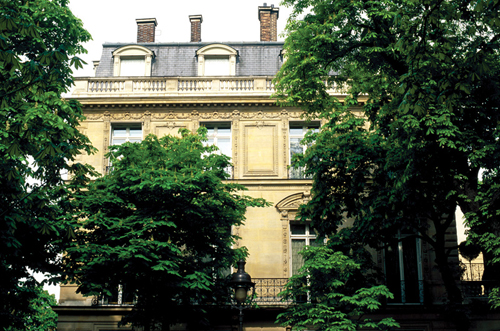A Day of Shopping
Morning
The
Champs-Elysées
is an area for leisurely strolls. Begin by window-shopping along one side of the avenue Montaigne,
where Prada, Nina Ricci, Dior and many more have their flagship stores –
the area oozes money. Have a break in the Bar des Théâtres, where
fashion names and the theatre crowd from the Comédie des Champs-Élysées
across the street sometimes hang out (
6 ave Montaigne
01 47 23 34 63).
Return up the other side of avenue Montaigne to
the Champs-Elysées, for the stroll to the Arc de Triomphe. Here you will
find many flagship shops of world-famous brands. Break for lunch at
Spoon, Food and Wine
, but get there early to get a table.
Afternoon
Continuing up the Champs-Elysées, look past the
showrooms and fast food outlets to note the many interesting buildings
which house them.
Take the underpass to the
Arc de Triomphe
and climb to the top for the views, which are superb at dusk when the avenues light up. Walk or take the metro to the rue du Faubourg-St-Honoré, for more designer shops.
For tea and cakes, La Galerie at the nearby Four Seasons George V hotel is a wonderfully elegant experience (served from 3–5pm).
International Connections
Avenue de Marigny
American author John Steinbeck lived here for five months in 1954 and described Parisians as “the luckiest people in the world”.

Avenue de Marigny
8 Rue Artois
Here,
in September 2001, the legendary Belgian mobster François Vanverbergh –
godfather of the French Connection gang – fell victim to a drive-by
assassin as he took his afternoon mineral water.
37 Avenue Montaigne
Having
wowed Paris with her comeback performances, iconic German actress and
singer Marlene Dietrich spent her reclusive final years in a luxury
apartment here.
Pont de l’Alma
Diana,
Princess of Wales, was killed in a tragic accident in the underpass
here in 1997. Her unofficial monument nearby attracts thousands of
visitors each year.
31 Avenue George V, Hôtel George V
A
roll-call of rockers – from the Rolling Stones and Jim Morrison to J-Lo
and Ricky Martin – have made this their regular Paris home-from-home.
Hôtel d’Elysée-Palace
Mata
Hari, the Dutch spy and exotic dancer, set up her lair in Room 113
before finally being arrested outside 25 Avenue Montaigne.
37 Avenue George V
Franklin
D. Roosevelt and his new bride visited his aunt’s apartment here in
1905. He was later commemorated in the name of a nearby avenue.

Avenue Franklin D. Roosevelt
49 Avenue des Champs-Elysées
Author
Charles Dickens may well have had “the best of times and the worst of
times” when he resided here from 1855–6. Ten years earlier he had also
lived at 38 Rue de Courcelles.
114 Avenue des Champs-Elysées
Brazilian
aviation pioneer Alberto Santos-Dumont planned many of his amazing
aeronautical feats – notably that of circling the Eiffel Tower in an
airship in 1901 – from this address.
102 Boulevard Haussmann
Hypochondriac author Marcel Proust lived in a soundproofed room here, turning memories into a masterwork.
Events on the Champs-Elysées
1616
Paris’s
grand avenue was first laid out when Marie de Médici, wife of Henri IV,
had a carriage route, the Cours-la-Reine (Queen’s Way), constructed
through the marshland along the Seine.
1667
Landscape
gardener Le Nôtre lengthened the Jardin des Tuileries to meet the
Cours-la-Reine, and opened up the view with a double row of chestnut
trees, creating the Grand Cours.
1709
The
avenue was re-named the Champs-Elysées (Elysian Fields). In Greek
mythology, the Elysian Fields were the “place of ideal happiness”, the
abode of the blessed after death.
1724
The Duke of Antin, overseer of the royal gardens, extended the avenue to the heights of Chaillot, the present site of the Arc de Triomphe.
1774
Architect
Jacques-Germain Soufflot lowered the hill of the Champs-Elysées by 5 m
(16 ft) to reduce the steep gradient, therefore making an easier and
safer passage for residents’ horses and carriages.
26 August 1944
Parisians
celebrated the liberation of the city from the German Nazi Occupation
of World War II with triumphant processions and festivities.
30 May 1968
The
infamous student demonstrations of May 1968, when student protests
against state authority spilled over into riots and massive gatherings.
De Gaulle and his supporters held a huge counter-demonstration here,
marking a turning point in the uprising.
12 November 1970
The
death of President Charles de Gaulle was an immense event in France, as
he had been the single most dominant French political figure for 30
years. He was honoured by a silent march along the Champs-Elysées.
14 July 1989
The
parade on Bastille Day marking the bicentennial of the Revolution, was a
dazzling display of folk culture and avant-garde theatre. It was a
distinct change from the usual military events, and was organized by
Mitterand’s Culture Minister, Jack Lang.
12 July 1998
Huge,
ecstatic crowds packed the Champs-Elysées to celebrate France’s
football team winning the World Cup. People came from all over Paris to
join in the festivities that captured the nation’s imagination.